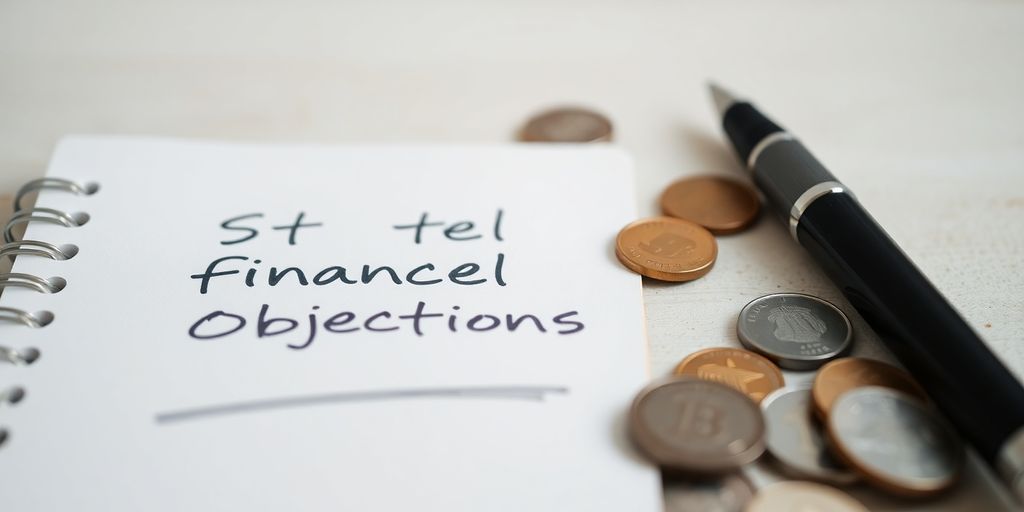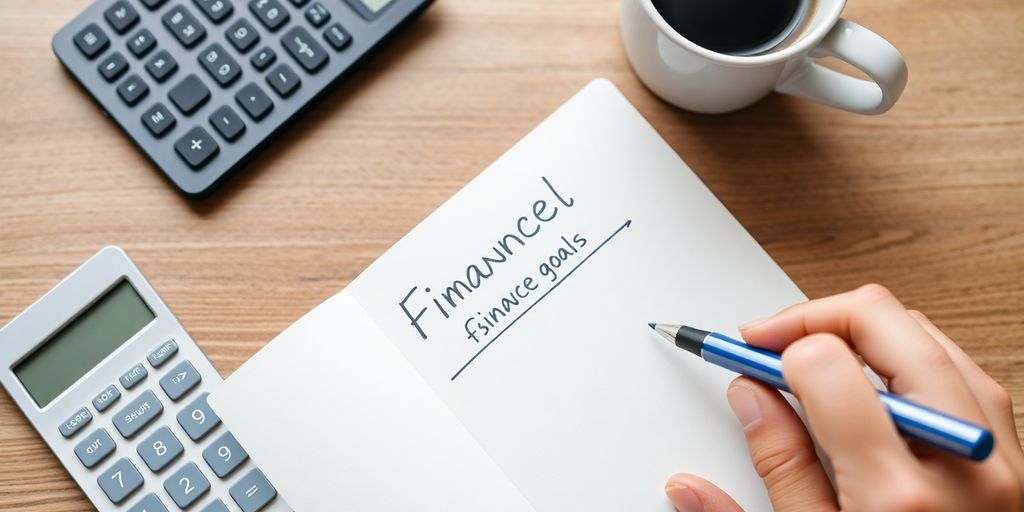
How To Set Short-Term Financial Goals
Setting short term financial goals is a smart way to take control of your finances. These goals can help you stay focused on what you want to achieve in the near future, whether it’s saving for a vacation, paying off debt, or building an emergency fund. In this guide, we’ll walk you through how to identify, plan, and achieve your short term financial goals so you can make your dreams a reality without getting overwhelmed.
Key Takeaways
- Short term financial goals typically take less than a year to achieve.
- It's important to be clear and specific about what you want to save for.
- Tracking your progress can help keep you motivated and on track.
- Automating your savings can make it easier to reach your goals.
- Regularly review your goals and adjust them if necessary.
Understanding Short Term Financial Goals

Defining Short Term Financial Goals
So, what exactly are short term financial goals? Well, they're basically the money moves you want to make in the near future, usually within a year or two. Think of them as stepping stones to your bigger, long-term dreams. It's not about some far-off retirement plan; it's about what you can realistically achieve in the here and now. These goals are all about setting clear financial goals that you can actually reach.
Importance of Short Term Financial Goals
Why bother with short term goals anyway? Because they're super important! They give you a sense of control over your money and help you build good financial habits. Plus, achieving these smaller goals can give you a real confidence boost, motivating you to tackle bigger challenges down the road. It's like, once you see you can save $500 in three months, suddenly saving for a down payment on a house doesn't seem so impossible.
Here's a few reasons why they matter:
- Motivation: Seeing progress keeps you going.
- Discipline: Sticking to a plan builds good habits.
- Flexibility: Short term goals can be adjusted as needed.
Short term financial goals are the building blocks of financial security. They provide immediate wins, reinforce positive behaviors, and create a solid foundation for long-term success.
Common Misconceptions About Short Term Goals
There are a few things people often get wrong about short term financial goals. One big one is thinking they're not important enough. Some people only focus on long-term investments and ignore the immediate needs. Another misconception is that they require a lot of money to get started. You can start small! Even saving $20 a week can make a difference. Also, people sometimes think that if they miss a goal, they've failed completely. It's okay to adjust your timeline or your target amount. The key is to keep moving forward. Don't let perfect be the enemy of good.
Identifying Your Short Term Financial Goals
Assessing Your Current Financial Situation
Okay, so before you start dreaming about that new gadget or weekend getaway, you gotta take a hard look at where you stand right now. This means understanding your income, expenses, debts, and assets. It's not always fun, but it's like checking the map before a road trip – you need to know your starting point. Gather all your financial statements, bank accounts, credit card bills, and any loan information. Calculate your net worth (assets minus liabilities). This gives you a clear picture of your financial health.
Prioritizing Your Financial Needs
Alright, so you know where your money is going, but is it going to the right places? Time to sort out what's a need versus a want. Needs are things like rent, food, transportation – stuff you can't really live without. Wants are those extras, like eating out, fancy coffee, or the latest tech. Make a list of your needs and wants, and then rank them in order of importance. This helps you see where you can potentially cut back on spending and redirect funds towards your short-term goals. It's all about making choices that align with what you truly value.
Setting Realistic Expectations
Look, it's great to be ambitious, but setting unrealistic goals is a recipe for disappointment. If you're currently saving $50 a month, aiming to save $1000 next month probably isn't going to happen. Be honest with yourself about what you can realistically achieve based on your current income and expenses. Consider factors like unexpected expenses, potential income fluctuations, and other financial obligations. Start small, celebrate those wins, and gradually increase your savings goals as you make progress.
Remember, it's a marathon, not a sprint. Small, consistent steps are more likely to lead to success than trying to make drastic changes overnight.
Here's an example of how you might break down a goal:
- Goal: Save $600 for a new laptop.
- Timeline: 6 months.
- Monthly Savings: $100.
This makes the goal feel much more manageable and achievable.
Creating a Plan for Short Term Financial Goals
Alright, so you've figured out what you want to achieve in the short term. Now comes the fun part: actually making it happen. It's not enough to just wish for that new gadget or a weekend getaway; you need a solid plan. Let's break down how to create a plan that works for you.
Establishing a Savings Timeline
First things first, figure out when you want to achieve your goal. Is it three months from now? Six? A year? This timeline is crucial because it dictates how aggressively you need to save. If you're aiming for something in three months, you'll need to put away a lot more each month than if you have a year. Be realistic. Don't set yourself up for failure by choosing an impossible deadline. Once you have a timeline, break it down into smaller, manageable chunks. How much do you need to save each week or month to stay on track? Write it down and stick to it.
Choosing the Right Savings Tools
Where you keep your money matters. For short-term goals, you want something safe and easily accessible. A regular savings account is a good start, but don't overlook other options. High-yield savings accounts offer better interest rates, meaning your money grows faster. Money market accounts are another option, often with slightly higher rates than regular savings accounts, but they might have minimum balance requirements. Certificates of Deposit (CDs) can also be useful, but keep in mind that your money will be locked up for a specific period. Choose the tool that best fits your timeline and risk tolerance.
Budgeting for Your Goals
This is where the rubber meets the road. You need to figure out how to squeeze those savings into your existing budget. Start by tracking your spending for a week or two. Where is your money actually going? You might be surprised. Once you have a clear picture, identify areas where you can cut back. Maybe it's eating out less, canceling subscriptions you don't use, or finding cheaper alternatives for things you already buy. Allocate that freed-up money towards your savings goal. Consider the importance of short term financial goals and adjust your budget accordingly. Remember, every little bit counts. Even small changes can add up over time.
Creating a budget doesn't have to be painful. Think of it as a roadmap to your financial goals. It's about making conscious choices about where your money goes, rather than letting it disappear without a trace. A well-crafted budget gives you control and empowers you to achieve your dreams.
Setting SMART Short Term Financial Goals

Specific Goals: What Do You Want to Achieve?
Okay, so you want to save money. Great! But vague goals are like trying to drive somewhere without a map. The more specific you are, the better. Instead of saying "I want to save money," try "I want to save $500 for a new laptop." That way, you know exactly what you're aiming for. Think about what truly matters to you. Is it a weekend getaway, paying off a credit card, or finally getting that new appliance? Pinpointing the exact item or experience makes it easier to stay motivated. It's about turning a general idea into a tangible target. This is the first step in setting financial goals.
Measurable Goals: How Will You Track Progress?
Now that you know what you want, you need to figure out how you'll know when you're getting there. "Measurable" means you can track your progress. Break down your big goal into smaller, manageable chunks. For example, if you want to save $1200 in six months, that's $200 a month.
Here's a simple way to track it:
| Month | Target Savings | Actual Savings | Difference |
|---|---|---|---|
| Month 1 | $200 | $150 | -$50 |
| Month 2 | $400 | $420 | +$20 |
| Month 3 | $600 | $600 | $0 |
Seeing those numbers go up (hopefully!) is a great motivator. Plus, if you fall behind, you'll know right away and can adjust your plan.
Achievable Goals: Are They Realistic?
This is where you need to be honest with yourself. It's awesome to dream big, but if your goals are totally out of reach, you're setting yourself up for disappointment. Can you really save $2000 a month on your current income? Maybe, but probably not. Look at your income and expenses. Figure out how much you can realistically save each month without sacrificing everything you enjoy. It's better to start small and succeed than to aim too high and give up. Remember, small wins build momentum. If you find that your goal is not achievable, consider adjusting the timeline or the amount you are trying to save. It's all about finding that sweet spot where it's challenging but doable.
Don't get discouraged if your initial goals seem too ambitious. It's a learning process. Re-evaluate your budget, look for ways to cut expenses, or explore opportunities to increase your income. The key is to stay flexible and adapt as needed. Your financial journey is a marathon, not a sprint.
Strategies for Achieving Short Term Financial Goals
Okay, so you've got your short-term financial goals all lined up. Now comes the fun part: actually reaching them! It's not always easy, but with the right strategies, you can totally make it happen. Think of it like leveling up in a game – each small win gets you closer to the big prize.
Automating Your Savings
Seriously, this is a game-changer. Set it and forget it! I'm talking about automating your savings. Decide how much you want to save each month, then set up a recurring transfer from your checking account to your savings account. It's like magic – money disappears from your account before you even have a chance to spend it. You can automate your savings strategy easily with most bank apps.
- Set up automatic transfers right after you get paid.
- Start small if you need to, and gradually increase the amount.
- Consider using different accounts for different goals.
Cutting Unnecessary Expenses
Alright, time to get real. Where is your money really going? Track your spending for a week or two. You might be surprised at how much you're spending on things you don't even really need. That daily latte? The impulse buys on Amazon? They add up!
Cutting expenses doesn't have to mean living like a monk. It's about being mindful of where your money goes and making conscious choices. Small changes can make a big difference over time.
Utilizing Financial Apps and Tools
There are so many cool financial apps and tools out there that can help you stay on track. Budgeting apps, investment apps, even apps that help you find deals and save money on groceries. Find a few that work for you and use them! They can make managing your money way easier and even a little bit fun. I personally like using apps that show me a visual representation of my spending habits. It's way more effective than just looking at a spreadsheet. Plus, many apps offer personalized advice and tips to help you reach your goals faster. It's like having a financial coach in your pocket!
Monitoring and Adjusting Your Short Term Financial Goals
It's easy to get excited when you first set your short-term financial goals. But life happens, and things change. That's why monitoring your progress and being ready to adjust your plans is super important. Think of it like this: you wouldn't set your GPS once and never check it again, right? Same goes for your money!
Regularly Reviewing Your Progress
Set aside some time each month to check in on your goals. Are you on track? Are you saving as much as you planned? Look at your bank statements, your budget, and any apps you're using to track your spending. This is where you see if your initial plan is actually working in the real world. Don't just glance at the numbers; really think about what they mean. For example, if you're saving for a vacation, check how much you've saved versus how much you need, and how many months you have left to save.
Making Adjustments as Needed
Okay, so maybe you're not on track. Don't panic! This is where the
Common Short Term Financial Goals
Building an Emergency Fund
Okay, so life happens, right? The car breaks down, the fridge gives up the ghost, or you have an unexpected medical bill. That's where an emergency fund comes in super handy. It's basically your financial safety net. Instead of reaching for a credit card (and racking up interest), you can tap into your emergency fund.
- Aim for 3-6 months' worth of living expenses.
- Start small, even $50 a month makes a difference.
- Keep it in an easily accessible, liquid account.
An emergency fund isn't about getting rich; it's about peace of mind. Knowing you have a cushion can seriously reduce stress when unexpected costs pop up. It's a total game-changer.
Saving for a Vacation
Who doesn't love a vacation? But vacations cost money, and that's where short-term saving comes in. Instead of going into debt for that beach getaway, plan ahead. Figure out where you want to go, how much it'll cost, and then start saving. You can use a savings timeline to help you stay on track.
- Set a specific savings goal.
- Break it down into monthly or weekly targets.
- Consider automating your savings.
Paying Off Small Debts
Small debts can be annoying. Credit card balances, smaller personal loans – they can drag you down. Tackling these debts head-on can free up cash flow and improve your credit score. It's like decluttering your finances.
- List all your small debts.
- Prioritize them (interest rate or balance – your call).
- Consider the debt snowball or avalanche method.
| Debt | Balance | Interest Rate | Monthly Payment | Strategy |
|---|---|---|---|---|
| Credit Card A | $500 | 18% | $25 | Pay extra $50/month |
| Loan B | $200 | 10% | $20 | Pay extra $30/month |
Wrapping It Up
So, there you have it. Setting short-term financial goals doesn’t have to be a headache. Just keep it simple and stick to what you can realistically achieve. Break your goals down into bite-sized pieces, and don’t forget to track your progress. Celebrate those small wins along the way—they really do add up! Whether it’s saving for a new gadget or building that emergency fund, having a plan makes it all feel more doable. Remember, it’s all about making your money work for you, not the other way around. Now go out there and start planning!
Frequently Asked Questions
What are short-term financial goals?
Short-term financial goals are targets you aim to reach within a year or so. They can include things like saving for a new phone or paying off a small debt.
Why are short-term financial goals important?
Short-term goals help you manage your money better and give you something to work towards. They can keep you motivated and prevent you from spending all your money.
How do I figure out my short-term financial goals?
Start by looking at your current money situation. Think about what you need or want to save for and decide which goals are most important to you.
What is a SMART goal?
A SMART goal is one that is Specific, Measurable, Achievable, Relevant, and Time-bound. This helps you set clear and realistic goals.
How can I save money for my short-term goals?
You can save money by setting up a budget, cutting back on unnecessary spending, and using savings accounts that offer good interest rates.
What are some examples of short-term financial goals?
Examples include building an emergency fund, saving for a vacation, or buying a new gadget. These goals can usually be achieved within a year.